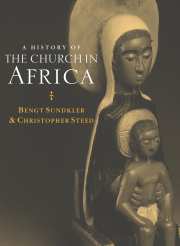Book contents
- Frontmatter
- Contents
- List of maps
- Acknowledgements
- List of abbreviations
- Introduction
- PART I THE FIRST FOURTEEN HUNDRED YEARS
- PART II THE MIDDLE AGES 1415 – 1787
- PART III THE LONG NINETEENTH CENTURY 1787 – 1919
- PART IV THE COLONIAL EXPERIENCE 1920 – 1959
- PART V INDEPENDENT AFRICA 1960 – 92
- 18 Introduction to Independent Africa
- 19 North and North-Eastern Africa
- 20 West Africa
- 21 Central Africa
- 22 Southern Africa
- 23 East Africa
- 24 Ecumenical Perspectives
- 25 Epilogue
- Notes
- Bibliography
- Name index
- Subject index
18 - Introduction to Independent Africa
from PART V - INDEPENDENT AFRICA 1960 – 92
Published online by Cambridge University Press: 16 September 2009
- Frontmatter
- Contents
- List of maps
- Acknowledgements
- List of abbreviations
- Introduction
- PART I THE FIRST FOURTEEN HUNDRED YEARS
- PART II THE MIDDLE AGES 1415 – 1787
- PART III THE LONG NINETEENTH CENTURY 1787 – 1919
- PART IV THE COLONIAL EXPERIENCE 1920 – 1959
- PART V INDEPENDENT AFRICA 1960 – 92
- 18 Introduction to Independent Africa
- 19 North and North-Eastern Africa
- 20 West Africa
- 21 Central Africa
- 22 Southern Africa
- 23 East Africa
- 24 Ecumenical Perspectives
- 25 Epilogue
- Notes
- Bibliography
- Name index
- Subject index
Summary
CHURCH AND STATE IN AFRICA
In 1955 representatives of twenty-nine ‘Third World’ nations from Asia and Africa met in Bandung, Indonesia. ‘We are united by race and religion’, the host, President Sukarno announced, somewhat exaggerating his claim. Only two men, although all the more colourful and significant, came from Africa: Nasser of Egypt and Nkrumah from Ghana. In 1941 Nkrumah had returned to Ghana after a decade in the United States and another two years in Britain. While abroad, he studied widely (amongst other things gaining a degree in theology!), observed the racial problems then besetting America and, most significantly of all, launched himself into pan-African and nationalist activity. In Ghana he was now to initiate a ‘Positive Action Campaign’. Soon he did more than that, for he became the inspiring conductor of a continent-wide orchestra, drums and all. His impetuous message was broadcast through newly-bought radio-sets in every village throughout the continent and set the tune for an impatient appeal echoed from country to country: not ‘Self-Government’ but ‘Self-Government Now’. His vision and action showed that Independence was within reach: a whole new generation of political leaders in Africa could follow the lead and the tune. In 1958 Nkrumah sponsored the first All African Peoples' Conference, held in Accra, and a forerunner of the Organization of African Unity (established in 1963).
The breathless speed with which this enormous political change took place is illustrated by A. A. J. van Bilsen's book and its message.
- Type
- Chapter
- Information
- A History of the Church in Africa , pp. 901 - 917Publisher: Cambridge University PressPrint publication year: 2000



